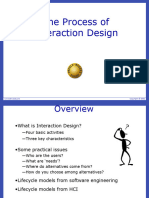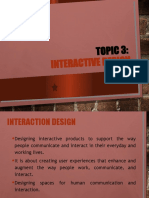Module4-process of interaction design
Uploaded by
jaymala.chavanModule4-process of interaction design
Uploaded by
jaymala.chavanStudy Notes on Interaction Design
2.1 Introduction
Designing a cloud-based service for sharing and curating digital content involves a structured
approach known as interaction design. This chapter explores the process of interaction design,
emphasizing user-centered design principles. It raises questions about the starting point for
design, whether to sketch interfaces, structure system architecture, or conduct user research.
Double Diamond Design Process
The Design Council of the UK outlines a double diamond model with four iterative phases:
Discover: Gather insights about the problem.
Define: Develop a clear brief framing the design challenge.
Develop: Create, prototype, test, and iterate solutions.
Deliver: Finalize, produce, and launch the project.
Interaction design follows these phases, focusing on user involvement throughout development.
2.2 What Is Involved in Interaction Design?
Interaction design encompasses activities aimed at discovering product requirements, designing
solutions, and producing prototypes for evaluation. It prioritizes user goals and experiences.
Understanding the Problem Space
Identifying the design problem is crucial. Designers must avoid jumping to technical solutions
without understanding user needs and context. For example, augmented reality navigation
systems have evolved through understanding user experiences and technological capabilities.
Importance of User Involvement
Involving users ensures the product is usable and meets their needs. Historically, developers
often consulted only managers or experts, neglecting direct user input. A product owner may
filter user feedback, but direct user involvement is essential for understanding real user goals.
Degrees of User Involvement
User involvement can range from full engagement to targeted participation. While full-time
involvement offers continuous input, it may lead to disconnect from the broader user community.
Techniques like personas can help maintain user focus in projects with limited involvement.
User-Centered Approach
A user-centered approach emphasizes real users and their goals as the driving force behind
product development. This involves early focus on users, empirical measurement of user
interactions, and iterative design processes.
Four Basic Activities of Interaction Design
Discovering Requirements: Understanding target users and their needs through data
gathering.
Designing Alternatives: Proposing ideas through conceptual and concrete design.
Prototyping: Creating interactive models for user evaluation.
Evaluating: Assessing usability and user experience throughout the design process.
2.2.6 A Simple Lifecycle Model for Interaction Design
The lifecycle model captures the relationship between the four activities of interaction design,
emphasizing the iterative nature of the process. It incorporates user-centered design principles,
ensuring that user feedback informs each stage of development.
2.3 Some Practical Issues
Several practical issues arise in interaction design, including:
Identifying who the users are.
Understanding users' needs.
Generating alternative designs.
Choosing among alternatives.
Integrating interaction design activities with other lifecycle models.
Identifying Users
Identifying users can be complex, as diverse user types may exist. Stakeholders include
customers, users, developers, and others affected by the product's success.
Understanding Users' Needs
Users may not articulate their needs clearly, especially for innovative products. Exploring the
problem space and conducting in-the-wild studies can reveal unrecognized user needs.
Generating Alternative Designs
Designers should avoid settling for "good enough" solutions. Alternatives can arise from
creativity, cross-fertilization of ideas, and inspiration from existing designs.
Choosing Among Alternatives
Choosing between designs involves user feedback and discussions about preferences.
Prototyping helps communicate designs effectively, allowing users to evaluate their experiences.
Integrating Interaction Design Activities
Interaction design must be integrated with other lifecycle models, particularly in agile software
development. Agile methods emphasize iteration, user feedback, and collaboration, enhancing
the user experience.
Conclusion
Interaction design is a comprehensive process that requires understanding user needs, generating
and evaluating design alternatives, and iterating based on feedback. By following a structured
approach, designers can create effective and user-centered products.
You might also like
- LN IT 312 02 Human Computer InteractionNo ratings yetLN IT 312 02 Human Computer Interaction21 pages
- Chapter02 - THE PROCESS OF INTERACTION DESIGNNo ratings yetChapter02 - THE PROCESS OF INTERACTION DESIGN19 pages
- CHAPTER-2-THE-PROCESS-OF-INTERACTION-DESIGNNo ratings yetCHAPTER-2-THE-PROCESS-OF-INTERACTION-DESIGN19 pages
- Chapter02 - THE PROCESS OF INTERACTION DESIGNNo ratings yetChapter02 - THE PROCESS OF INTERACTION DESIGN19 pages
- Chapter02 - ID5e The Process of Interaction DesignNo ratings yetChapter02 - ID5e The Process of Interaction Design19 pages
- Chapter02 The Process of Interaction DesignNo ratings yetChapter02 The Process of Interaction Design19 pages
- Interaction Design - A Process Importance of Involving UsersNo ratings yetInteraction Design - A Process Importance of Involving Users5 pages
- Chapter 9 The Process of Interaction DesignNo ratings yetChapter 9 The Process of Interaction Design26 pages
- Design Process and Prototyping Chapter 3 - Part 2: Sub-TopicNo ratings yetDesign Process and Prototyping Chapter 3 - Part 2: Sub-Topic36 pages
- Interaction Design Notes by Jennifer PreeceNo ratings yetInteraction Design Notes by Jennifer Preece54 pages
- Week 1: Class Introduction: Chapter 1: What Is Interaction Design? ANDNo ratings yetWeek 1: Class Introduction: Chapter 1: What Is Interaction Design? AND4 pages
- HCI Lesson 7 - Process of Interaction DesignNo ratings yetHCI Lesson 7 - Process of Interaction Design25 pages
- What Is Design? A Simple Definition Is: - Achieving Within: Goals ConstraintsNo ratings yetWhat Is Design? A Simple Definition Is: - Achieving Within: Goals Constraints27 pages
- LESSON 1 - TOPIC 3 - Interaction DesignNo ratings yetLESSON 1 - TOPIC 3 - Interaction Design23 pages
- Interaction Design and HCI in The Software ProcessNo ratings yetInteraction Design and HCI in The Software Process46 pages
- Blending Design Thinking with DevOps Practices: Bridging Concepts with DevOps for Superior InnovationFrom EverandBlending Design Thinking with DevOps Practices: Bridging Concepts with DevOps for Superior InnovationNo ratings yet
- Lesson 14.: Unit Iii. 21 Century LiteraciesNo ratings yetLesson 14.: Unit Iii. 21 Century Literacies70 pages
- Scripting Languages (Python) - SuggestionNo ratings yetScripting Languages (Python) - Suggestion4 pages
- 10 Must Read Forex Trading Quotes - ICT Tradings 2No ratings yet10 Must Read Forex Trading Quotes - ICT Tradings 21 page
- Early Years: Because They Don't Come With A ManualNo ratings yetEarly Years: Because They Don't Come With A Manual462 pages
- Sample Paper - 2010 Class - IX Subject - Mathematics: X X X X A BNo ratings yetSample Paper - 2010 Class - IX Subject - Mathematics: X X X X A B6 pages
- Developing Your Intuition Develop Clairvoyance0% (2)Developing Your Intuition Develop Clairvoyance2 pages
- 28 - Tradition Modernity and The Muslim EpistemologyNo ratings yet28 - Tradition Modernity and The Muslim Epistemology6 pages
- How To Prepare For The UPSC EPFO Enforcement Officer Exam - QuoraNo ratings yetHow To Prepare For The UPSC EPFO Enforcement Officer Exam - Quora2 pages
- Personal Information: Scholarship Application FormNo ratings yetPersonal Information: Scholarship Application Form9 pages






























































































